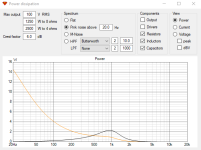Hello New Here. I am a weekend local sound provider. I have a small club system.
Anyways I am loading 4x small wedge monitors. they are 12" x 1" little guys.
So I measured my boxes and best I can figure by my "close as I can get bending a tape measure" measurements the box is approx 1 cu ft sealed. So I punched up a bunch of differant speakers into a calculator till I came up with one that suited a 1.15cu ft sealed box and comes out to be 3db down @ 79Hz. I bought cheapo PRV D280Ti-S compression drivers and ABS 11x4" 90x40deg horns.
Now not knowing the frequency graph of the woofer I just went with the horn drivers recomended crossover point of 1.8K 12Db. I purchased ACT 15 crossovers off ebay. They have a -12Db attenuation for the horns as my horns are 109Db sens. and the woofer is 97Db sens. I realize this is NOT gonna be a Phase aligned perfect crossover setup, but trying to make it best it can be and Ill massage the rest with a graphic EQ.
This is a link to the crossovers schematic.
Can any of your more technical guys tell me if I can add a zodel accross the woofers terminals without messing up the crossover? I allready calculated using an online calculator what resistor and cap I'd need, just not too savy with crossovers.

Anyways I am loading 4x small wedge monitors. they are 12" x 1" little guys.
So I measured my boxes and best I can figure by my "close as I can get bending a tape measure" measurements the box is approx 1 cu ft sealed. So I punched up a bunch of differant speakers into a calculator till I came up with one that suited a 1.15cu ft sealed box and comes out to be 3db down @ 79Hz. I bought cheapo PRV D280Ti-S compression drivers and ABS 11x4" 90x40deg horns.
Now not knowing the frequency graph of the woofer I just went with the horn drivers recomended crossover point of 1.8K 12Db. I purchased ACT 15 crossovers off ebay. They have a -12Db attenuation for the horns as my horns are 109Db sens. and the woofer is 97Db sens. I realize this is NOT gonna be a Phase aligned perfect crossover setup, but trying to make it best it can be and Ill massage the rest with a graphic EQ.
This is a link to the crossovers schematic.
Can any of your more technical guys tell me if I can add a zodel accross the woofers terminals without messing up the crossover? I allready calculated using an online calculator what resistor and cap I'd need, just not too savy with crossovers.






